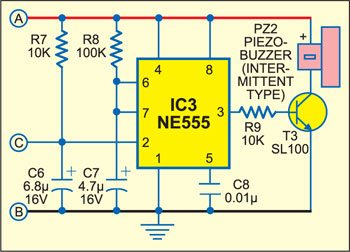 For car protection, custom made units are available but they are costly. Here’s an inexpensive car protection unit to protect car stereo, etc. from pilferage that costs less and requires no adjustments in the car but a good car cover.
For car protection, custom made units are available but they are costly. Here’s an inexpensive car protection unit to protect car stereo, etc. from pilferage that costs less and requires no adjustments in the car but a good car cover.
Place the circuit at your bedside and bring the two wires from the unit to the car (parked outside your home) and connect one wire-end to the cover and the other to the ground, with both wire-ends shorted by some weight such as a brick. So outwardly the mechanism is not visible.
Car protection unit circuit

If someone tries to remove the cover, the alarm of the circuit starts sounding to alert you. The alarm can be switched off by resetting it using switch S1.
The car protection circuit comprises two timer ICs: one for the alarm circuit (see IC2 in Fig.1) and the other to indicate that the battery has taken over as the power source (see IC3 in Fig. 2). Normally, the protector operates off AC mains and the battery takes over only when mains fail. As the battery current is not high, the battery will last long.
Circuit operation
As long as the two wires remain shorted, transistor T1 remains cut off. When shorting is removed, transistor T1 gets forward biased and its collector voltage drops to trigger IC2 and the piezobuzzer starts sounding.
If mains fails, the battery-takeover indicator (shown in Fig. 2 and connected to points A, B and C in Fig. 1) immediately gets triggered at pin 2 of IC3. Its high output activates the battery-operation alarm for a couple of seconds. IC1 draws power from the battery to activate the protection unit.
After setting up the unit properly and shorting both the wires, press test switch S2. If there is no fault in the circuit, the alarm will sound. Now release test switch S2 and momentarily press reset switch S1 to switch off the alarm.
The article was first published in July 2005 and has recently been updated.






